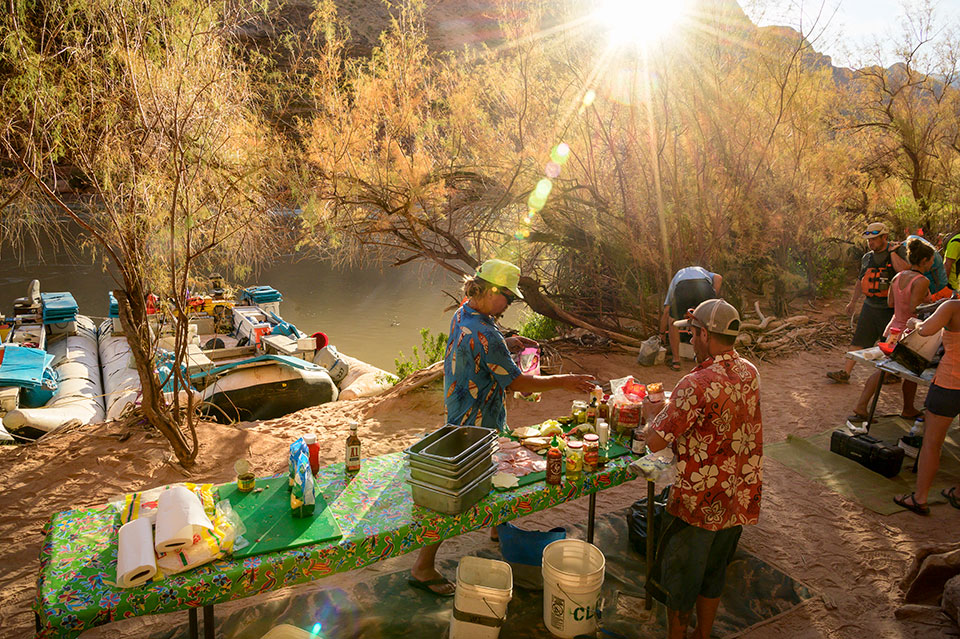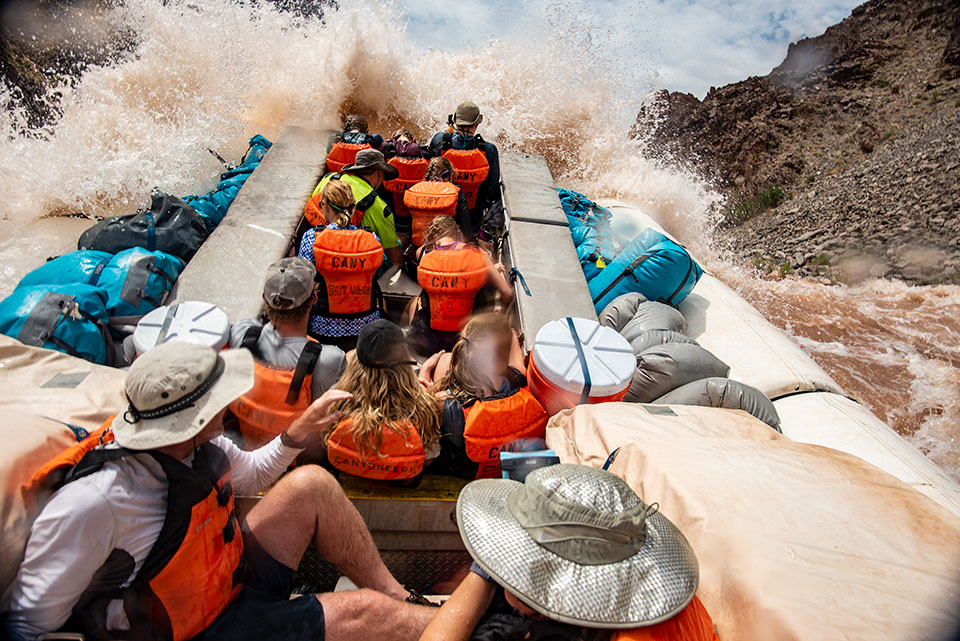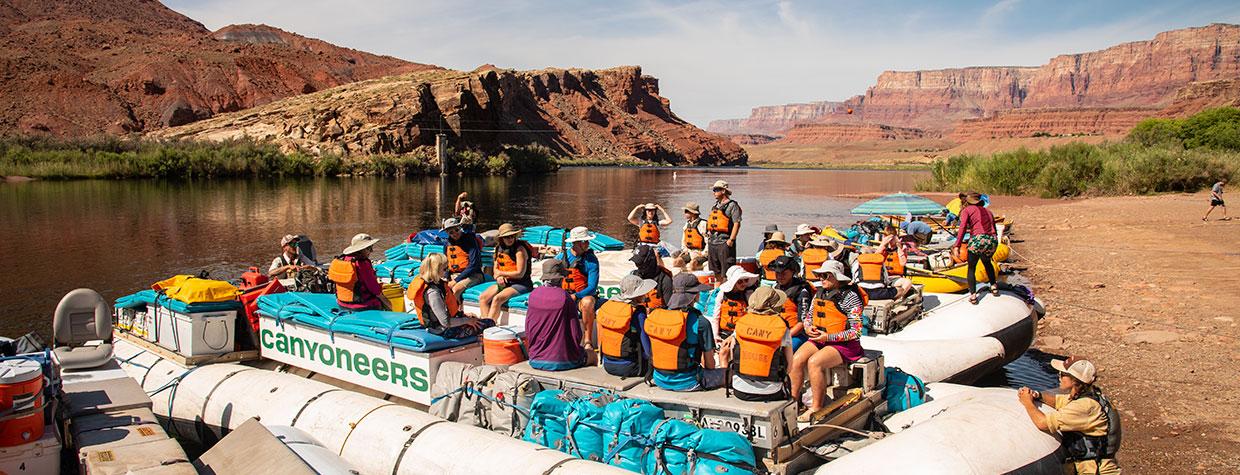The boats might be dories, jumbo motor rigs or modest rowing rafts, and the groups might be large or small. But one thing is constant when it comes to rafting trips through the Grand Canyon: After weeks of anticipation, everyone is itching to get on the water. Another constant is the scene along the edge of the Colorado River at Lees Ferry every hot summer morning. On these days, everyone is excited about getting plastered by whitewater.
The boatmen prepare their passengers with a safety briefing, a loading of the final duffel and a last check of the personal flotation devices, or PFDs. Then the passengers step aboard and, finally, they are floating on the fabled Colorado. Soon, the Canyon and its ubiquitous sand will begin creeping into every heart and mind — not to mention ears and hair. For a few days, a week or even longer, the group will be embraced by the Canyon, and some of these newbie river runners will never be the same. The river, and the Canyon, can do that to you. I know: I was one of the innocents when I first boarded a dory 54 years ago.
Just about all of us know something about Grand Canyon river trips: the big rapids, the lovely camping beaches, the astonishing side-canyon oases. But what about all of the preparations the commercial outfitters make in support of multi-day river trips? What about the terrific food, the specialized boats, the pilot training and the endless gallons of cold drinks? Who makes sure there’s enough ice to survive 110-degree summer days and ensures that the motors will purr while half-underwater in Lava Falls Rapid?
To find out, I speak with Rachel Unger, one of the managers of Flagstaff-based Arizona River Runners. ARR is one of 16 National Park Service-authorized Grand Canyon river guiding companies, and Unger says a large team stands behind ARR’s boatmen, whom the passengers see as the face of the business. (Because Unger has a background as a motor boatman, she talks primarily about the motorboat portion of ARR’s operation, but the company also offers rowing trips.)
About 50 boatmen work for the company, including those who are employed by partner group Grand Canyon Whitewater. Most boatmen work only during the summer months, but a few, including Unger, work year-round performing equipment maintenance, coordinating with other support companies and conferring with the Park Service.
It’s a constant challenge to keep up with yearly changes and upgrades, Unger says. For instance, the boat motors have recently been switched from pull-start models to battery-start versions that also are more resistant to rock hits, an inevitable hazard in the Canyon. In the past year, the company purchased 50 of these beauties, marking a significant break from tradition and experience; the coming seasons will reveal how this innovation holds up. There are constant small changes, too: Hand-washing stations and camp chairs are among today’s standard amenities but weren’t seen on river trips until the 1980s and ’90s.

ARR and Grand Canyon Whitewater also employ about 10 truck drivers who trailer the boats to where river trips begin and end — each full (277-mile) version of Canyon river trips requires more than 700 miles of driving. And at the Flagstaff warehouse, five or six warehouse workers swarm over dry-docked boats almost every summer day to clear out unopened leftover food (much of which is passed on to a local homeless shelter), wash the vessels and their supply boxes, and remove duffel bags for cleaning and laundering.
PFDs, cots, tents, chairs and kitchen equipment are checked. Dishes are washed. Damaged equipment is replaced or repaired. Portable toilets are picked up by a virtuous service company, cleaned and returned ready for “reloading” by future guests. Propane tanks are replaced. Sleeping bags and sheets are laundered and repacked. Food supplies are restocked. Up to 20 cases of soft drinks, about
500 cans, are loaded into the lower levels of the two big motor rigs that travel together, and passengers will often add their own favorite drinks. (All aluminum cans are recycled at trip’s end.) The all-important ice chests are refilled just before departure.
Checklists are supremely important, given the grim shortage of convenience stores along the impending 277-mile journey. If, however, a crucial item has been forgotten or lost, any commercial company boatman can go to another on the river to get help — everyone works together to make all Canyon river trips successful.
Gas tanks are topped off just before departure, too. Each boat carries a spare motor, and if there was a motoring “incident” on the previous trip, that motor has been checked or replaced. The previous crew is always interviewed, allowing the company to probe for irregularities in the behavior of the motor or boat. Sometimes, the warehouse crew must have the boats ready to go out again the next day, and when the schedule is this tight, the boatmen may not have a day off — a tough turnaround when inner-Canyon high temperatures are well over 100 degrees.
But which do you think river guides prefer: preparing the boats in Flagstaff’s cool weather and being able to go home at day’s end, or running the river when temperatures are sizzling and they’re guiding a pack of newbies? Of course, they prefer the latter, in part because they never know what surprises the Canyon will provide or what the newbies will say or do. Among the questions they’ve heard: “Mr. Boatman, do we get off the river where we started?” “What’s behind these rock walls?” And: “What held back the water in Lake Powell before they built the dam?”
By the time a rafting trip has reached the foot of the Canyon, the river will have plunged almost 2,000 feet and stacked up countless indelible memories for passengers and their guides. But it takes more than supplies and equipment to make a great river trip. The ultimate preparations are made years in advance by the boatmen (a term that describes men and women alike). What makes a great boatman? A deep love for the Canyon, the skills to pilot a boat between rocks at constantly changing river flows, the tenacity to pass the necessary medical and food-handling tests, and the ability to work as part of a team for long hours in high heat.

And there’s one other factor: sympathy. When guests sign up for a Canyon river trip, they might not fully grasp what the unique river environment will require. To keep themselves and others safe and preserve the Canyon’s pristine character, lifestyle modification is necessary, and that often involves the surrender of some privacy and convenience. When the Canyon — the heat, the water, the sand — chafes at the edges of “normal,” boatmen must be sympathetic. Sometimes, it takes patience to make a tolerable Canyon rafter out of a hardwired city slicker.
And what does this new river runner gain in return for an unconventional lifestyle? Entry into a world of glorious wilderness punctuated by moments of exhilaration — or alarm, depending on their persuasion. More importantly, they earn an appreciation for our dynamic planet. The big rapids help make that point crystal clear, but so do the Canyon’s cliffs. A detailed geological history isn’t necessary, but the cliffs are a reminder that many generations of mountains, oceans, canyons, plants and animals have had their time in the sun at this location before there was a Grand Canyon. The rocks record some of this geological pageant, and an awakening to Earth’s astonishing history, facilitated by a knowledgeable river guide, is priceless.
When I ask Rachel Unger, “How did you get into this line of work?” her answer is direct: “You did it!” That’s because Rachel is my niece. She was my passenger in the Canyon in 2001 — when, for the first and only time, I flipped my little wooden dory. That was in House Rock Rapid. I guess Rachel liked it. I didn’t.
As a family, we’ve had some wild times in the Canyon, both backpacking and river running. Rachel’s mother (my sister) and I were on the Colorado more than 40 years ago, when it was careening along at 83,000 cubic feet per second. The river pinned one of our three dories on the rocks, and we were forced to leave it behind — an unpleasant but memorable day. This year, Rachel’s parents will make more memories by celebrating their 50th wedding anniversary on the river, with Rachel at the helm. There’s something in the Canyon’s sand, I think, that can get into a person’s soul and even penetrate a family’s DNA.
So, this summer, when the dories or rafts are ready to go at Lees Ferry and the passengers step aboard, they, as always, won’t know what awaits. Downpours? Rainbows? Sandstorms? Surprise love affairs? It’s all part of the flow of the river: the swirling whirlpools, the rapids and the other wonders of time below the rim.

